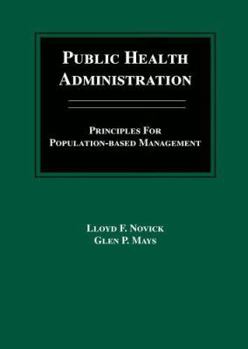Public Health Administration: Principles for Population-Based Management
Public Health This description may be from another edition of this product.
Format:Hardcover
Language:English
ISBN:0763735221
ISBN13:9780763735227
Release Date:December 2004
Publisher:Jones & Bartlett Publishers
Length:806 Pages
Weight:3.55 lbs.
Customer Reviews
5 ratings
Public Health Student- great review
Published by Thriftbooks.com User , 15 years ago
Great price and great service. The textbook arrived earlier than I anticipated. Will definitely use them again. The text was very informative but brief. Gives an overview of many topics.
Stimulating and enjoyable read
Published by Thriftbooks.com User , 15 years ago
Novick, Morrow, and Mays collaborated very well in writing this text. The material was comprehensive, detailed, and current. The publish date is 2008, so many of the examples cited throughout the book are situations that I am experiencing in the health care field today, or have recently read about in the media. This somehow allows for a stronger foundation of understanding for the materials presented by the authors. I enjoyed reading this text, and plan on using it as a reference in the future.
Public Health Administration: Principles for Population-Based Management
Published by Thriftbooks.com User , 17 years ago
This text by authors Novick and Mays is a must-read for public and community health graduate students or professionals. It contains a "wealth" of pertinent and current information in a user-friendly manner. It should be considered a classic reference text as it provides a foundation of information in a global or well-rounded manner. I look forward to further subsequent texts offered by these authors. My summer was spent reading this text, this was a truly Splendid reading experience...
satisfied customer
Published by Thriftbooks.com User , 18 years ago
Book arrived earlier than expected, 2 business days as opposed to the four expected.
A focused book on public health management and practices
Published by Thriftbooks.com User , 23 years ago
This recent contribution to public health literature focuses on management and administrative strategies for entire communities rather than specific programs or organizations. The 800-page text is divided into four Parts dealing with conceptual and structural elements; operational issues; administrative processes and strategies, and applications of these to public health administration. There are thirty chapters contributed by fifty-four public health experts from local and state agencies, medical, public health and nursing schools, universities, non-government organizations, laboratories, and five chapters written by CDC-based professionals. Each Part has an introduction by the editors, followed by a series of chapters, with individual pr¨¦cis of the chapter¡¯s focus, along with telegraph-style, boxed-chapter reviews, and a complete set of historical and contemporary references. The chapters are enriched by carefully chosen figures, tables and ¡°exhibits¡±, which are crisp, attractive, and interesting to view. The figures, tables and exhibits have been carefully chosen by the authors, culled from selected articles and books; others have been created by the editors to support the written text. They leaven the written narratives, and provide a further continuity to the logical flow in chapter chronology. A brief Epilogue, rationalizing population management, is followed by a fifteen page glossary with over 250 public health definitions, terms, abbreviations, neologisms, and Americanisms, provides the reader with a Rosetta stone summary of both old, established expressions, as well as newer public health terminology. Public Health Administration is freed from constraints of previous textbooks on preventive medicine and public healthþuwhich were required to discuss topics like nutrition, biostatistics, epidemiology and communicable diseases. These efforts often drove the textbook, resulting in all too brief summaries of these subjects, while providing a cramped backseat to what otherwise would have been devoted to a full discussion of public health management. Despite the fact that the fifty-odd contributors come from a spectrum of public health disciplines and locations (over twenty different states and Canada), the editors have worked hard to produce a single narrative voice, and have eliminated redundancies and conflicts between various authors. Individual chapters include standard analyses of core U.S. public health practices, the editors have generic issues (e.g. Leadership) applicable to any country¡¯s structured health system, and have the largest chapter in the book (62 pages) devoted to Disaster Preparedness and Response, which includes ten pages (with many 2000 references) devoted to bioterrorism. The text would be an excellent resource for academics involved with teaching, as well as their students. Local, regional and federal public health practitioners would also benefit from a one-stop shopping for information on public health, as wou




